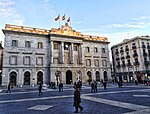Jaume I (Barcelona Metro)

Jaume I is a station in the Barcelona Metro network, located under Via Laietana, an important avenue in Ciutat Vella, right between Plaça de Ramon Berenguer el Gran and Plaça d'Emili Vilanova. It can be accessed from Plaça de l'Àngel and Carrer d'Argenteria, on the other side of Via Laietana. It currently serves Transports Metropolitans de Barcelona-operated L4, but was originally designed in 1926 as one of the stations of the first L3 service, a section of which became L4. The other L3 stations (Correos and Banco) located in Via Laietana are all closed nowadays. Its two platforms, unusually for a downtown Barcelona metro station, are both located on the same level, with a wall between them dividing the station in two parts. They are each 94 m (308 ft) long. On December 28, 2018, the station became accessible for wheelchair users.
Excerpt from the Wikipedia article Jaume I (Barcelona Metro) (License: CC BY-SA 3.0, Authors, Images).Jaume I (Barcelona Metro)
Via Laietana, Barcelona
Geographical coordinates (GPS) Address Nearby Places Show on map
Geographical coordinates (GPS)
| Latitude | Longitude |
|---|---|
| N 41.383888888889 ° | E 2.1788888888889 ° |
Address
Via Laietana 16
08003 Barcelona (Ciutat Vella)
Catalonia, Spain
Open on Google Maps











